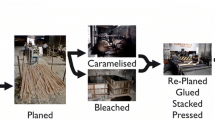Abstract
The objective of this study was to determine the technical feasibility of producing a structural composite from Calcutta bamboo. The first article on surface characteristics published in this series addressed pH, buffer capacity, wetting, and surface energy (Ahmad and Kamke 2003). In this paper, the physical and mechanical characteristics were considered for their variability with respect to location along the length of the bamboo culm, nodes versus internodes section, and radial versus tangential directions. The physical and mechanical characteristics were also compared to timber species commonly used in the manufacture of structural composites. The characteristics studied were found to have some variability at different locations, sections, and directions. Calcutta bamboo was found to have similar physical and mechanical characteristics to commercial timber species in Malaysia and North America.


Similar content being viewed by others
References
Ahmad M, Kamke FA (2003) Analysis of Calcutta bamboo for structural composite materials: surface characteristics. Wood Sci Technol 37(3–4):233–240
American Society of Testing Materials (ASTM) (1997a) Standard test methods for specific gravity of wood and wood-based materials. Annual book of ASTM standards Des, vol–4.10. Philadelphia, PA, D 2395-93 (Reapproved 1997)
American Society of Testing Materials (ASTM) (1997b) Standard guide for moisture conditioning of wood and wood-based materials. Annual book of ASTM standards Des, vol 4.10. Philadelphia, PA, D 4933-91
American Society of Testing Materials (ASTM) (1997c) Standard methods of testing small clear specimens of timber. Annual book of ASTM standards Des. ASTM, vol 4.10. Philadelphia, PA, D 143-94 (Reapproved 1997)
American Society of Testing Materials (ASTM) (1997d) Standard practice for maintaining constant relative humidity by means of aqueous solution. Annual book of ASTM standards Des, vol 11.3. Philadelphia, PA, E 104-85 (Reapproved 1996)
Aminuddin M, Abd. Latif M (1991) Bamboo in Malaysia: past, present and future research. Proceedings of the 4th International bamboo workshop. Bamboo in Asia and the Pacific. Chiangmai, Thailand. November 27–30, pp 349–354
Anon (1972) The use of bamboo and reeds in building construction. Department of economic and social affairs. United Nations, New York
Anon (1992) Proceeding IUFRO DIV.V/ITTO/FROM. International Workshop on Improved Utilization of Timber Resources in Southeast Asia. 7–11 December 1992, Kuala Lumpur, Malaysia
Bodig J, Jayne BA (1982) Mechanics of wood and wood composites. Van Nostrand Reinhold Company
Espiloy ZB, Ella AB, Floresca AR (1986) Physico-mechanical properties and anatomical structure relationships of two erect bamboo species. Philippines Lumberman 32(4):25–27
Farrelly D (1984) The book of bamboo. Sierra Club Books, San Francisco, California
Forest Products Laboratory (FPL) (1999) Wood handbook: wood as an engineering material. FRS catalogue no. 7269, U.S. Department of Agriculture, p 3-1
Hearn EJ (1997) Mechanics of materials. An introduction to the mechanics of elastic and plastic deformation of solids and structural materials, 3rd edn. University of Warwick, U.K. Butterworth, Heinemann
Janssen JJA (1991) Mechanical properties of bamboo. Forestry Sciences, vol 37. Kluwer Academic, New York
Kumar S, Dobriyal PB (1992) Treatability and flow path studies in bamboo. Part 1. Dendrocalamus strictus nees. Wood Fiber Sci 24(2):113–117
Lee AWC, Xuesong B, Perry NP (1994) Selected physical and mechanical properties of giant timber bamboo grown in South Carolina. Forest Prod J 44(9):40–46
Limaye VD (1952) Strength of bamboo (Dendrocalamus strictus). Indian Forest Records 1(1):1–17
Sattar MA, Kabir MF, Bhattacharjee DK (1991) Effect of age and height position of Muli (Melocanna baccifera) and Borak (Bambusa balsooa) bamboo on their physical and mechanical properties. Proceedings of the 4th International Bamboo Workshop. Bamboo in Asia and the Pacific, Chiangmai, Thailand
Siau JF (1995) Wood: influence of moisture on physical properties. Department of wood science and forest products, Virginia Polytechnic Institute and State University
Tewari DN (1992) A monograph on bamboo. International book distribution. Dehra Dun, India
Acknowledgments
The authors would like to thank Universiti Teknologi MARA for funding the project.
Author information
Authors and Affiliations
Corresponding authors
Rights and permissions
About this article
Cite this article
Ahmad, M., Kamke, F.A. Analysis of Calcutta bamboo for structural composite materials: physical and mechanical properties. Wood Sci Technol 39, 448–459 (2005). https://doi.org/10.1007/s00226-005-0016-y
Received:
Published:
Issue Date:
DOI: https://doi.org/10.1007/s00226-005-0016-y




